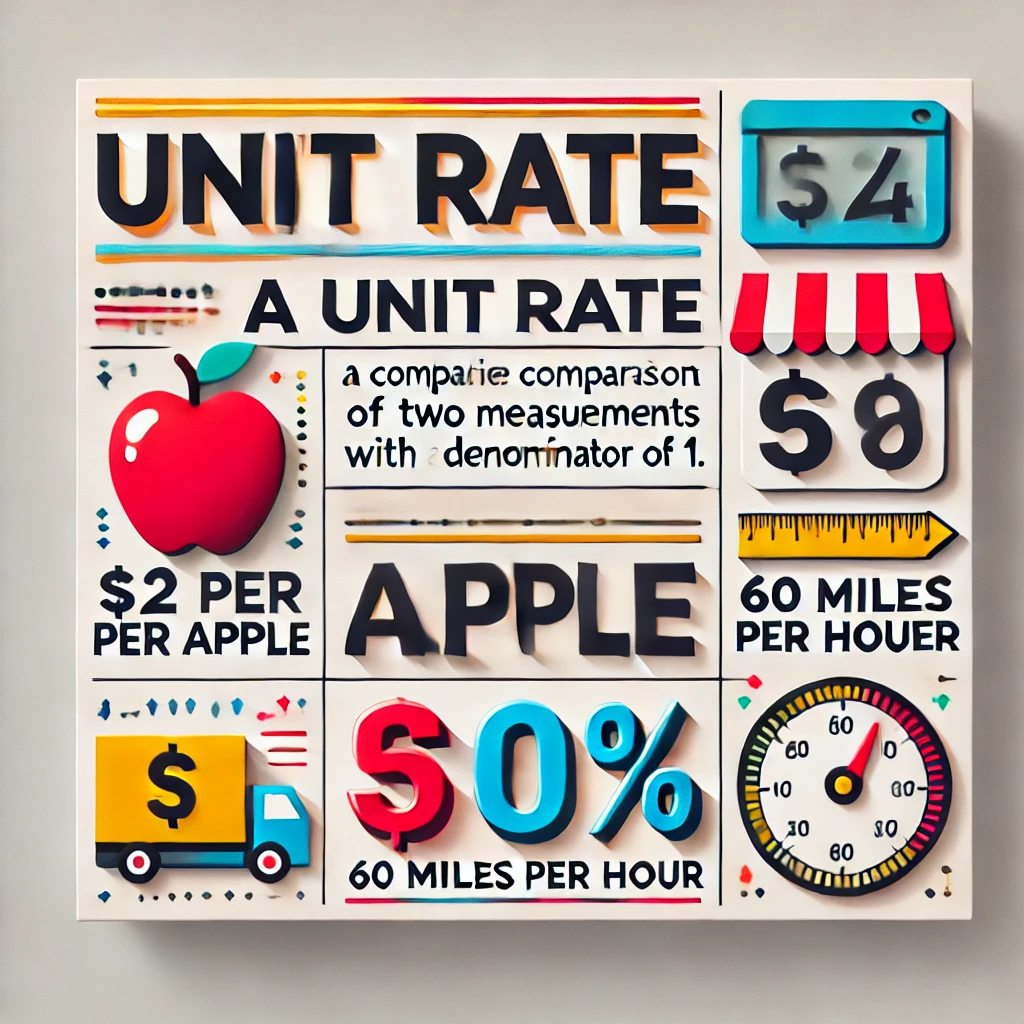Unit Rate Definition
A unit rate is a special type of ratio that compares a quantity to one unit of another quantity.

It tells you how much of one thing there is for every single unit of another thing. For example, miles per hour (mph) tells you how many miles are travelled in one hour.
Why are unit rates important?
Unit rates are important because they make it easy to compare different quantities. They also simplify calculations and help us make informed decisions. For example, knowing the unit price of items at the supermarket helps us choose the best deal.
How do you calculate a unit rate?
To calculate a unit rate, you divide one quantity by another quantity. The denominator (the number you divide by) should represent a single unit of the measurement you are interested in. For example, to find the price per apple if a bag of 10 apples costs £2, you would divide £2 by 10 apples: £2 / 10 apples = £0.20 per apple.
What are some real-life examples of unit rates?
Unit rates are all around us! Some common examples include:
- Speed: miles per hour (mph), kilometres per hour (km/h)
- Pricing: price per item, cost per pound, cost per ounce
- Fuel efficiency: miles per gallon (mpg), kilometres per litre (km/l)
- Cooking: cups of flour per loaf of bread, teaspoons of sugar per serving
What is the difference between a unit rate and other rates?
The key difference is that a unit rate always has a denominator of one. Other rates may compare quantities but don’t necessarily simplify to a single unit. For example, “4 apples for £1” is a rate, but it’s not a unit rate. The unit rate would be £0.25 per apple.
How can I use unit rates to save money?
Unit rates are incredibly useful for comparing prices. When shopping, calculate the unit price (e.g., price per ounce) of different products to determine which one offers the best value for your money.
What are some common mistakes people make with unit rates?
Here are a few pitfalls to avoid:
- Not simplifying the unit rate: Ensure your final answer expresses the relationship per single unit.
- Confusing units: Double-check that your units are consistent throughout the calculation.
- Not double-checking calculations: Simple arithmetic errors can throw off your results.
How are unit rates taught in school?
Unit rates are typically introduced in primary school as part of learning about ratios and proportions. Teachers often use visual aids and relatable examples to make the concept clear. As students progress, they learn to apply unit rates in more complex scenarios, including algebra, geometry, and science.
Unit Rates Study Guide
Instructions: Answer the following questions in 2-3 sentences each.
- What is a unit rate?
- Why are unit rates important in everyday life? Provide one example.
- Explain the steps involved in calculating a unit rate.
- Give two real-life examples of unit rates that are not related to speed or pricing.
- How is a unit rate different from a regular rate?
- How can understanding unit rates help you save money when shopping?
- What is one common mistake people make when working with unit rates?
- Explain how a teacher might introduce the concept of unit rates to primary school students.
- How can unit rates be applied in more complex situations beyond basic arithmetic?
- Why is understanding unit rates important for financial literacy?
Answer Key
- A unit rate is a ratio that compares a quantity to one unit of another quantity. It expresses how much of one thing there is for every single unit of another thing.
- Unit rates simplify comparisons and help us make informed decisions. For example, knowing the fuel efficiency of a car in miles per gallon (mpg) helps us choose a car that is more economical to run.
- To calculate a unit rate, identify the two quantities being compared and then divide the first quantity by the second quantity. Ensure that the second quantity represents a single unit of measurement.
- In cooking, cups of flour per loaf of bread is a unit rate. In productivity, tasks completed per hour is another example of a unit rate.
- A unit rate always has a denominator of one, meaning it expresses the amount per single unit. Other rates may compare quantities but do not necessarily simplify to a single unit.
- By calculating the unit price of different products (e.g., price per ounce), you can determine which product offers the best value for your money.
- One common mistake is not simplifying the unit rate to its lowest terms, leading to potentially inaccurate comparisons.
- A teacher might use visual aids like blocks or counters to represent quantities and then demonstrate how to group them to find the amount per single unit. They might also use relatable examples, like sharing cookies equally among students.
- Unit rates can be used in algebra to solve proportions, in geometry to calculate density, and in science to analyse experimental data.
- Understanding unit rates helps individuals compare prices, evaluate loan options, and understand interest rates, empowering them to make informed financial decisions.
Essay Questions
- Discuss the importance of unit rates in everyday life, providing at least three detailed examples from different contexts.
- Explain how understanding unit rates can help individuals make informed decisions when shopping. Use specific scenarios to illustrate your points.
- Compare and contrast unit rates with other types of rates. Discuss the advantages and disadvantages of each and provide examples.
- Describe various methods that educators can utilize to effectively teach unit rates to students of different age groups.
- Explore the connection between unit rates and financial literacy. Explain how understanding unit rates can empower individuals to make sound financial decisions.